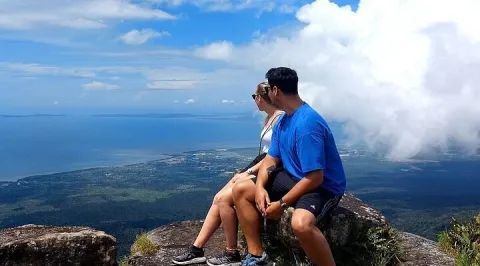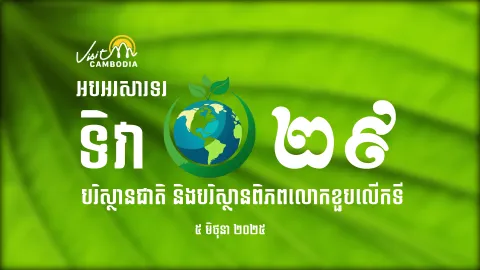Geography
柬埔寨是一个位于印度支那半岛的东南亚国家。它西部和西北部与泰国接壤,北部与老挝接壤,东部和东南部与越南接壤。该国的南部海岸线沿泰国湾展开,拥有多种海岸景观。柬埔寨的总面积约为181,035平方公里,略小于美国的俄克拉荷马州。该国的地形主要由低洼的中央平原组成,属于更大的湄公河流域的一部分。湄公河是世界上主要的河流之一,从北到南流经柬埔寨,为农业、渔业和交通提供重要资源。托恩里萨湖,东南亚最大的淡水湖,是另一个重要的地理特征,在季风季节显著膨胀,并支持广泛的内陆渔业
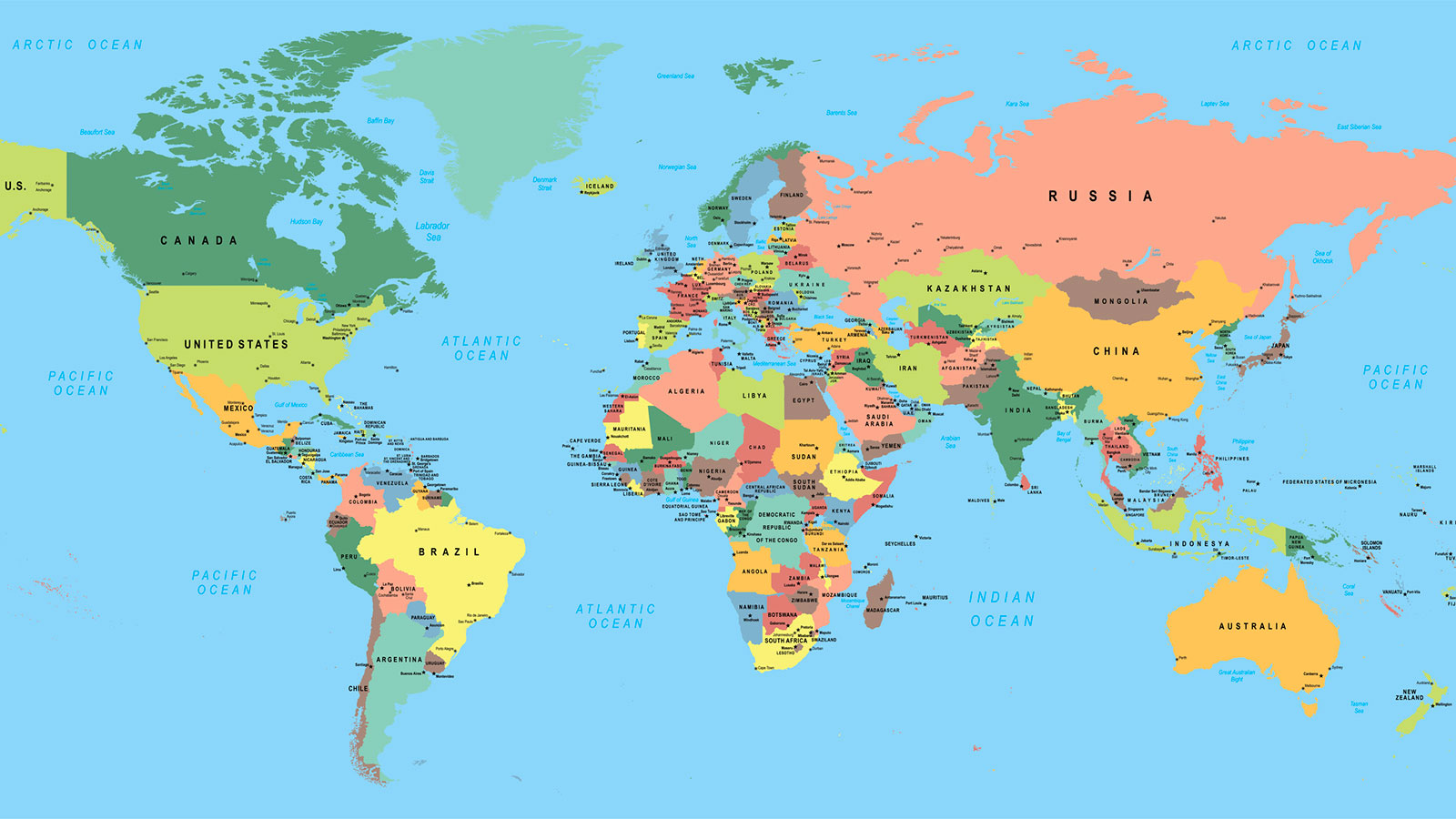
位于中央平原的北部和西部是卡达蒙山和丹格雷山。特别是卡达蒙山,是一个重要的生态区域,拥有丰富的生物多样性和茂密的热带雨林。这些山脉不仅与邻国形成自然边界,还为该国多样的地形和气候做出了贡献。柬埔寨拥有热带季风气候,分为两个截然不同的季节:湿季从五月到十月,干季从十一月到四月。湿季期间,强降雨滋养了该国的农业土地,特别是主导乡村景观的稻田。而干季则特点是湿度较低,气温较凉,成为旅游的最佳时机。该国的自然景观与其地形一样多样,从肥沃的稻田和郁郁葱葱的森林到沿南部海岸的原始海滩和岛屿。西哈努克市是一个受欢迎的海滨城市,附近的岛屿提供美丽的海滩和清澈的海水,使其成为本地和国际游客的热门目的地。柬埔寨的地理不仅塑造了其经济,还定义了人们的日常生活,许多社区依赖土地和水源维持生计。
历史
柬埔寨的历史是东南亚最引人入胜的故事之一,紧密与高棉帝国的兴衰息息相关。高棉帝国从9世纪到15世纪繁荣发展,是东南亚最强大和最具影响力的帝国之一,扩展其影响力至今天的泰国、老挝和越南大部分地区。高棉帝国的持久遗产是吴哥遗址,其中吴哥窟是最著名和最重要的纪念碑,最初建造为印度教寺庙,后来转变为佛教寺庙。
高棉帝国在15世纪的衰退导致了一个不稳定的时期,并失去了领土给邻近的王国。到了19世纪,柬埔寨已成为一个失去独立的国家,夹在泰国和越南之间,并被用作它们在争取独立过程中互相博弈的棋子。这段动荡时期为法国的干预奠定了基础,法国干预始于1863年,当时诺罗敦一世国王与法国签署了一项条约,使柬埔寨成为法国的保护国,并最终成为法属印度支那的一部分。

在法国殖民时期,柬埔寨在社会、经济和政治方面发生了显著变化。法国人引入了新的基础设施,包括道路、铁路和城市开发,这些都帮助现代化了该国。然而,殖民政府也征收了沉重的税收,并剥削柬埔寨的资源,导致民众的不满日益加剧。这种不满最终推动了民族主义运动的兴起,并呼吁独立。柬埔寨在1953年在诺罗敦·西哈努克国王的领导下从法国获得独立,西哈努克在国家的后殖民发展中发挥了核心作用。独立初期,国家相对稳定与繁荣,通常被称为柬埔寨的“黄金时代”。然而,该国很快卷入了地区冲突,尤其是在越南战争期间,战争蔓延到柬埔寨,造成了灾难性的后果。柬埔寨现代历史上最黑暗的一章是红色高棉的崛起,这是一个由波尔·布特领导的激进共产主义政权。从1975年到1979年,红色高棉通过处决、强迫劳动和饥饿进行了一场残酷的运动,导致200万人死亡。红色高棉时代在柬埔寨社会留下了深深的创伤,至今该国仍在恢复与和解的过程中。
文化
柬埔寨的文化是由其悠久的历史和多样的影响塑造而成的丰富画卷。柬埔寨文化的核心是佛教,佛教在大多数柬埔寨人的日常生活中扮演着重要角色。上座部佛教是柬埔寨的主要佛教形式,它影响着从宗教仪式到社会习俗和价值观的一切。寺庙,通常称为塔庙,遍布全国,作为社区生活和精神实践的中心。柬埔寨文化最具象征性的表达之一是其经典舞蹈,特别是阿普萨拉舞,它起源于高棉帝国的皇宫。阿普萨拉舞者穿着精美的服饰,佩戴金饰,表演优雅而富有象征意义的动作,讲述着神灵、英雄和神话生物的故事。这种舞蹈与其他形式的传统音乐和戏剧一起,继续成为柬埔寨文化遗产的重要组成部分,常常在文化活动和节庆中演出。

柬埔寨的节日充满活力,并深深扎根于该国的文化和宗教传统之中。最重要的节日之一是柬埔寨新年,通常在四月庆祝,标志着丰收季节的结束。这个节日是一个更新的时刻,家庭成员团聚一起,向祖先表达敬意,向塔庙奉献供品,并参与传统的游戏和舞蹈。另一个重要的节日是“普春盆”(Pchum Ben),这是一个持续15天的宗教活动,柬埔寨人通过向僧侣献上食物和拜访塔庙来纪念他们的祖先。
柬埔寨的艺术和手工艺是其文化的另一个重要方面,拥有悠久的丝绸编织、陶艺、木雕和石雕传统。这些工艺中使用的复杂设计和技术代代相传,常常反映出古代高棉艺术中的主题和图案。例如,吴哥窟的浮雕描绘了《罗摩衍那》和《摩诃婆罗多》中的场景,以及高棉帝国时期的日常生活。这些艺术传统至今仍在蓬勃发展,艺术家和工匠们致力于保护和推广柬埔寨的文化遗产。
柬埔寨语言——高棉语,是该国文化认同的重要组成部分。高棉语不仅是柬埔寨的官方语言,也是传递国家历史、文学和口头传统的关键媒介。这种语言起源于古代高棉字母,受印度婆罗米文字的影响,并经历了数百年的演变。高棉文学,特别是古典诗歌和民间故事,仍然是柬埔寨文化的重要组成部分,为人们提供了对柬埔寨人民的价值观、信仰和经历的深刻洞察。
经济
柬埔寨的经济在过去几十年经历了显著的转型,从一个以农业为主的社会转变为更加多元化的经济体。农业仍然是柬埔寨经济的基石,为大量人口提供就业,并对国家的GDP作出重要贡献。稻米是主要的农业产品,柬埔寨是世界上主要的稻米出口国之一。其他重要的农业产品还包括橡胶、木薯和各种水果与蔬菜。纺织和服装行业是另一个对柬埔寨经济产生重大影响的关键部门,对国家的出口做出了重要贡献。柬埔寨已成为全球服装行业的重要参与者,许多工厂为国际品牌生产服装。这个行业是推动柬埔寨经济发展的动力之一,提供了数百万人的就业机会,特别是女性。然而,该行业也面临一些挑战,包括劳动权利问题以及来自生产成本较低国家的竞争。旅游业是柬埔寨另一个快速发展的行业,得益于该国丰富的文化遗产、历史遗址和自然美景。吴哥窟作为联合国教科文组织世界遗产,是世界上最受欢迎的旅游目的地之一,吸引了数百万国际游客。其他受欢迎的旅游目的地还包括金边、海滨城市西哈努克市以及卡达蒙山的生态旅游区。

近年来,柬埔寨的建筑和房地产行业也实现了增长,这得益于外国投资和城市化进程。建筑业的繁荣在金边尤为明显,新的摩天大楼、购物中心和住宅综合体已经改变了这座城市的天际线。虽然这些发展创造了新的机会,但也引发了关于环境可持续性、城市规划和当地社区迁移的担忧。尽管有这些进展,柬埔寨仍面临着一些显著的经济挑战,包括贫困、收入不平等和对外国援助的依赖。该国也容易受到外部冲击的影响,如全球对其出口需求的波动以及气候变化对农业的影响。为了应对这些挑战,柬埔寨正在专注于改善基础设施、教育和治理,并吸引在新兴领域如科技和可再生能源的投资。这些努力旨在为未来创造一个更加具有韧性和可持续性的经济。
旅游
旅游是柬埔寨经济的重要组成部分,也是吸引世界各地游客的主要亮点。该国以其历史遗址而闻名,特别是吴哥考古公园,那里有世界著名的吴哥窟寺庙群。这个遗址是联合国教科文组织的世界遗产,常被认为是东南亚最重要的考古遗址之一,也是柬埔寨丰富文化遗产的象征。吴哥的寺庙每年吸引数百万游客,为他们提供一窥高棉帝国宏伟景象的机会。除了吴哥窟,柬埔寨还提供了多种吸引不同类型游客的景点。首都金边是一个繁忙的大都市,融合了现代发展与历史地标。皇家宫殿、银塔和国家博物馆是必须参观的景点,为游客提供了了解柬埔寨王室历史和文化遗物的机会。城市中的活力市场,如中央市场和俄罗斯市场,也很受游客欢迎,游客可以在这里购买当地的手工艺品、纺织品和纪念品。对于那些对柬埔寨自然美景感兴趣的人来说,南部海岸和岛屿提供了原始的沙滩、清澈的海水和悠闲的氛围。西哈努克市是通往柬埔寨岛屿的门户,如柬式龙岛(Koh Rong)和宋龙岛(Koh Rong Samloem),这些岛屿以其迷人的沙滩以及卓越的潜水和浮潜机会而闻名。这些目的地为游客提供了一个远离城市喧嚣的宁静度假胜地,越来越受到背包客和奢华游客的欢迎。
柬埔寨还提供多种生态旅游体验,特别是在该国的山区和森林地区。例如,卡尔达蒙山脉是密集热带雨林、稀有野生动植物和原住民社区的家园。游客可以通过有导游的徒步旅行、野生动物观察和支持当地保护工作的社区旅游项目来探索这一地区。东北省份,如拉塔纳基里和蒙多基里,也提供类似的体验,游客可以参观瀑布、大象保护区和传统的部落村庄。文化和历史旅游则通过参观讲述柬埔寨近代历史的遗址得到了进一步丰富。金边的图尔斯陵种族屠杀博物馆和楚英厄克大屠杀遗址是红色高棉政权时期暴行的严肃提醒。这些遗址对于理解柬埔寨人民的坚韧和国家持续努力从过去创伤中恢复具有重要意义。总体来说,柬埔寨的旅游业提供了多样的体验,展示了该国的自然美景、丰富文化和深厚历史。
人们
柬埔寨人民,通常被称为柬埔寨人或高棉人,是这个国家的核心和灵魂。柬埔寨大约90%的居民属于高棉族,这个民族的历史可以追溯到一千多年前。高棉语是柬埔寨的官方语言,是他们文化身份的重要组成部分。高棉语在政府、教育和媒体中被广泛使用,也是柬埔寨丰富文化遗产得以代代相传的媒介。柬埔寨还有几个少数民族群体,每个群体都为国家的文化多样性做出了贡献。查姆人是一个主要信仰伊斯兰教的少数民族群体,他们拥有自己的语言和文化习俗。高地部落,通常被称为“高棉洛厄”(Khmer Loeu),居住在柬埔寨偏远的山区。这些群体包括布农族、坦普安族和扎赖族等,他们各自拥有独特的语言、传统和生活方式。这些群体的文化实践通常与自然环境紧密相连,反映了与土地的深厚联系。
宗教在柬埔寨人的生活中占据着核心地位,大约95%的人口信奉上座部佛教,这是该国主要的宗教信仰。佛教影响着日常生活的许多方面,从指导社会行为的道德和伦理价值观,到标志重要人生事件的仪式和庆典。僧侣在柬埔寨社会中受到高度尊敬,许多年轻男子会在寺庙中作为初学僧修行,学习佛教教义并为社区做出贡献。家庭是柬埔寨社会的基石,亲戚之间的紧密联系构成了社会生活的基础。大家庭往往住得很近,照顾年迈父母和支持兄弟姐妹是一种深厚的责任感。这种以家庭为中心的文化在柬埔寨人庆祝节日时得以体现,如高棉新年和普春宾节,家人会团聚在一起,祭拜祖先,加强彼此的社区联系。
柬埔寨的历史对其人民产生了深远的影响,特别是红色高棉时期的事件,带来了巨大的痛苦和损失。尽管经历了这些苦难,柬埔寨人民以其坚韧、温暖和慷慨而闻名。好客是柬埔寨文化的一个重要部分,游客常常受到热情接待,被视为贵宾。这种友善和社区精神是柬埔寨人民的显著特征,使得这个国家不仅是一个充满历史和文化兴趣的地方,也是一个充满深厚人际联系的地方。
美食
柬埔寨美食,常常被邻国泰国和越南的烹饪传统所掩盖,是东南亚美食世界中的一颗隐藏宝石。柬式料理的特色在于其味道的平衡——咸、甜、酸和苦——通常通过使用如香茅、卡菲尔青柠叶、罗望子和鱼露等食材来实现。米饭是柬埔寨餐点的主食,通常与各种菜肴一起食用,从汤类、炒菜到烤肉和咖喱都有。最著名的柬埔寨菜肴之一是阿莫克(Amok),这是一道香气四溢的咖喱,传统上是用鱼、椰浆和一种叫做kroeung的调料酱做成的,这种酱料由香茅、姜黄和高良姜等香料和草药混合而成。这道菜通常用香蕉叶蒸制,赋予它独特的口感和风味。阿莫克不仅是当地人最喜爱的菜肴,也是游客体验正宗柬式美食的必试之选。

另一个受欢迎的菜肴是诺姆班卓克(Nom Banh Chok),常被称为柬式米粉。这道菜由米粉组成,上面浇有用发酵鱼酱、姜黄和新鲜香草做成的绿色鱼汁,通常还会搭配生蔬菜和香蕉花一起食用。诺姆班卓克通常是早餐常见的食物,是许多柬埔寨家庭的主食之一。
Lok Lak 是另一道标志性的柬式菜肴,通常是用腌制的牛肉炒制而成,配上一种由青柠汁、黑胡椒和盐调制的酸味蘸料。牛肉常常与新鲜蔬菜、米饭和煎蛋一起食用。Lok Lak 反映了法国烹饪对柬埔寨美食的影响,尤其是在使用黑胡椒方面,黑胡椒是在殖民时期引入的。
柬埔寨的街头小吃也是烹饪体验的重要组成部分。市场和街头摊位提供各种小吃和菜肴,从串烧肉类和炸昆虫到甜点如农安宋(Num Ansom),这是一种糯米糕,里面包着香蕉或绿豆,并用香蕉叶包裹。热闹的市场为人们提供了品尝各种地方风味和发现柬式美食多样性的机会。
总体而言,柬埔寨美食是该国历史、地理和文化影响的体现。虽然它与邻国的美食有相似之处,但它具有自己独特的身份,这种身份是由当地食材和传统烹饪方法塑造的。无论是在高端餐厅就餐还是品尝街头小吃,前往柬埔寨的游客都一定能找到丰富且充满风味的烹饪体验。
政府与政治
柬埔寨是一个实行议会制的宪政君主国,国王是国家元首,首相是政府首脑。柬埔寨的君主制备受尊敬,国王被视为国家团结与延续的象征。尽管国王的角色主要是礼仪性的,但他在宗教和文化事务以及国家活动和仪式中扮演着重要角色。政府的行政部门由首相领导,首相由国王任命,通常是国民议会中多数党或联盟的领导人。首相拥有重要权力,负责监督行政部门、实施法律以及指导国家政策。柬埔寨现任首相洪马内于2023年上任,接替了其父亲洪森,后者担任首相近四十年。洪马内的领导标志着柬埔寨政治的新篇章,关注点集中在他如何应对国家的挑战并继续推动国家的发展轨迹。
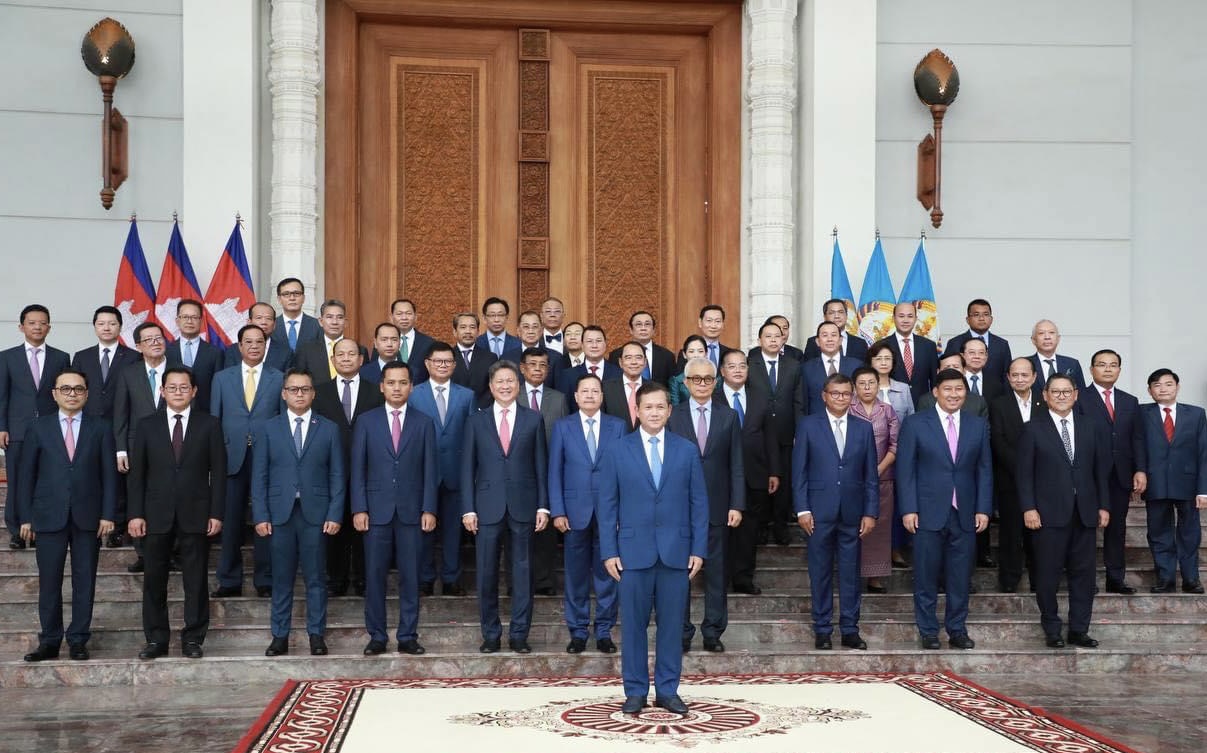
柬埔寨的立法部门是两院制,由国民议会和参议院组成。国民议会,或称下议院,由125名成员组成,这些成员通过普选选举产生,任期为五年。参议院,或称上议院,拥有62名成员,其中一些成员由国王任命,另一些则由国民议会和地方议会的成员选举产生。立法部门负责制定法律、批准预算并监督行政部门。柬埔寨的政治格局受其动荡历史的影响,包括红色高棉政权的遗产和随后的内战。自1990年代以来,柬埔寨在重建其政治制度方面取得了显著进展,当时联合国赞助的和平协议促成了民主政府的建立。然而,柬埔寨的政治体制也面临着缺乏透明度、腐败指控以及对政治反对派和媒体自由的限制等批评。柬埔寨的外交政策着重于与东南亚邻国以及中国和美国等全球大国保持良好关系。该国是东南亚国家联盟(ASEAN)的成员,并在区域外交和经济合作中发挥积极作用。近年来,柬埔寨与中国的紧密关系尤为显著,中国的投资和援助在该国经济发展中扮演了重要角色。然而,这一关系也引发了关于债务依赖和环境影响等问题的争议。
生活方式
柬埔寨人的生活方式深受该国丰富的文化遗产、强烈的家庭纽带以及乡村和城市生活节奏的影响。在乡村地区,那里是大多数人居住的地方,日常生活围绕农业展开,特别是稻米种植。家庭成员通常一起在田间工作,根据季节进行种植和收割。这种与土地的紧密联系塑造了乡村生活的许多方面,包括社会习惯、节日庆典和饮食习惯。在柬埔寨的乡村,社区生活充满活力且富有合作精神。人们通常生活在扩展家庭单位中,多代同堂或居住在彼此邻近的地方。社会互动频繁且重要,邻里之间互帮互助,协作完成农业任务、组织宗教仪式和共同庆祝节日。乡村的寺庙是宗教和社会生活的中心,大家聚集在那里进行崇拜、学习和社区活动。 慢行之路 | 柬埔寨的日常生活

柬埔寨的城市生活与乡村地区的较慢节奏形成鲜明对比。首都金边是一座繁忙的大都市,拥有不断增长的人口,并融合了现代与传统的生活方式。这座城市是一个多元化的社会,居民包括政府官员、商人、学生和外籍人士。金边的生活方式反映了该国迅速的城市化进程和经济发展,越来越多的人在建筑、零售和服务等行业工作。教育在柬埔寨社会中被高度重视,近年来在改善教育机会方面取得了显著进展。政府也采取了措施提高识字率,并提供更多的高等教育机会。然而,挑战依然存在,尤其是在乡村地区,资源和基础设施有限。尽管面临这些挑战,教育仍被视为提高生活质量和实现社会流动的重要途径。柬埔寨的生活方式还受到其精神和文化实践的影响。佛教在日常生活中扮演着核心角色,许多柬埔寨人会进行宗教仪式、在寺庙献供,并参与节庆活动。传统艺术,如舞蹈、音乐和手工艺,仍然被传承和庆祝,通常是世代相传的。同时,现代影响,如西方时尚、娱乐和科技,在城市地区日益显现,促进了柬埔寨生活方式的动态发展。
挑战与机遇
柬埔寨在继续发展并融入全球经济的过程中面临一系列挑战。最紧迫的问题之一是贫困,特别是在农村地区,人口中有相当一部分生活在贫困线以下。尽管经济增长,但收入不平等仍然是一个问题,财富分配和获取医疗、教育等服务存在差距。解决这些问题需要继续在社会项目、基础设施和就业创造方面进行投资。环境可持续性是柬
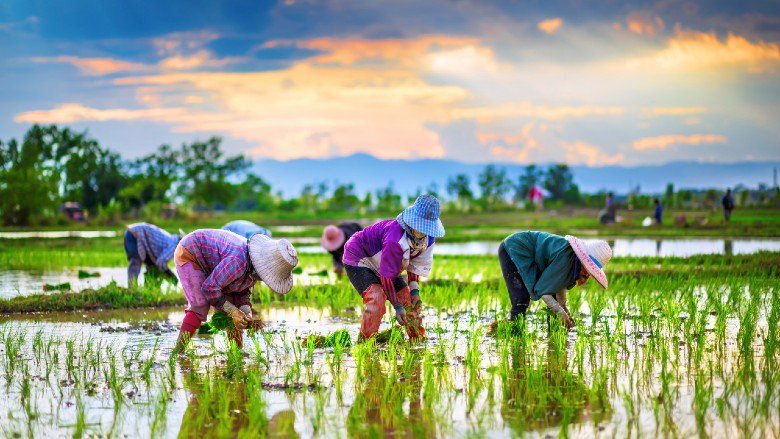
治理和政治稳定也是关键的关注领域。柬埔寨在建设民主制度方面取得了一定进展,但腐败、人权侵犯和对政治自由的限制等问题仍然在削弱公众信任和国际关系。加强法治,确保公正的选举,推动透明度是建设一个更加公正和稳定的社会的关键。另一方面,柬埔寨有着巨大的增长和发展的机会。该国年轻且不断增长的人口提供了人口红利,具有推动创新和经济扩展的潜力。投资于教育、技能发展和企业家精神可以充分利用这一潜力,创造更加充满活力和竞争力的经济。柬埔寨在东南亚的战略位置,加上其在区域组织如东盟中的成员身份,为贸易、投资和区域合作提供了机会。该国丰富的文化遗产和自然美景也为进一步发展旅游业提供了潜力,这可以创造就业机会并产生收入。通过解决挑战并利用其机遇,柬埔寨可以继续为其人民建设一个更加光明和繁荣的未来。
人民与文化
柬埔寨人民,被称为柬埔寨人或高棉人,是这个国家的核心和灵魂。柬埔寨大部分人口,大约90%,属于高棉族群,拥有超过千年的历史。高棉语是柬埔寨的官方语言,是他们文化身份的重要组成部分。高棉语广泛应用于政府、教育和媒体,是柬埔寨丰富文化遗产代代相传的载体。柬埔寨也居住着几个少数民族群体,每个群体都为国家的文化多样性做出了贡献。占族人是其中最大的少数民族之一,主要信仰伊斯兰教,拥有自己的语言和文化习俗。高地部落,通常被称为“高棉洛厄”人,居住在柬埔寨偏远的山区。这些群体包括布农族、坦普安族和贾莱族等,每个群体都有独特的语言、传统和生活方式。这些群体的文化习俗通常与自然环境紧密相连,体现了与土地的深厚联系。
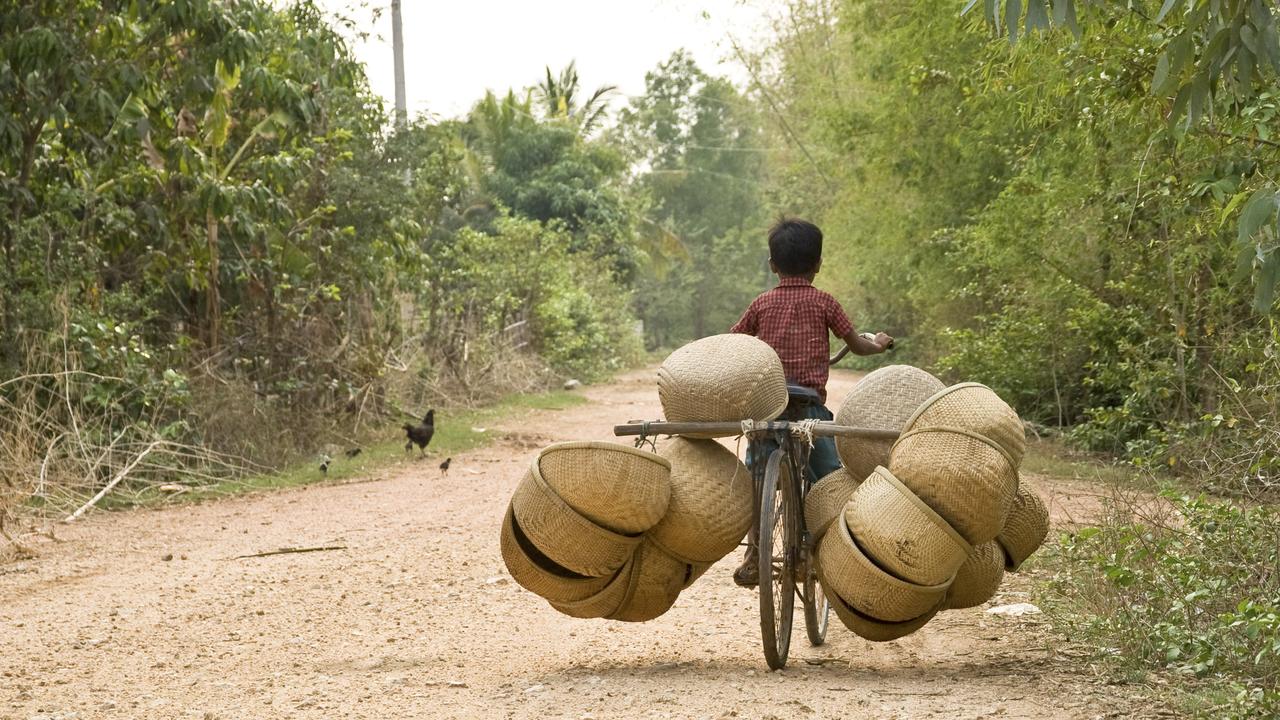
宗教在柬埔寨人的生活中发挥着核心作用,约95%的人口信奉上座部佛教,这一信仰主导了柬埔寨的宗教生活。佛教影响着日常生活的许多方面,从引导社会行为的道德和伦理价值观到标志重要生活事件的仪式和典礼。僧侣在柬埔寨社会中备受尊敬,许多年轻人会在寺庙中作为新僧修行,学习佛教教义,并为社区做出贡献。家庭是柬埔寨社会的基石,亲戚之间的紧密联系构成了社会生活的基础。大家庭通常住得很近,并且有着强烈的责任感,照顾年老的父母并支持兄弟姐妹。这种以家庭为中心的文化在柬埔寨人庆祝节日的方式中得到了体现,例如柬式新年和Pchum Ben节,这些节日是家庭团聚、向祖先表示敬意和加强共同联系的时刻。柬埔寨的历史对其人民产生了深远的影响,特别是红色高棉时期的事件,给人民带来了巨大的痛苦和失落。尽管经历了这些困难,柬埔寨人民以其坚韧、热情和慷慨著称。待客之道是柬埔寨文化的重要组成部分,访客常常受到热情款待,并被视为贵宾。这种友善和社区精神是柬埔寨人民的一个重要特征,使这个国家不仅成为一个具有历史和文化意义的地方,也成为一个充满深刻人际联系的地方。
柬埔寨的文化是一幅由传统、信仰和实践编织而成的丰富画卷,受到其悠久历史和多样化影响的塑造。佛教是柬埔寨文化的核心,佛教在大多数柬埔寨人的日常生活中发挥着至关重要的作用。上座部佛教是柬埔寨的主要佛教形式,影响着从宗教仪式到社会风俗和价值观的一切。寺庙,称为“塔”,遍布全国,是社区生活和精神实践的中心。柬埔寨文化最具标志性的表现之一是其古典舞蹈,特别是阿普萨拉舞,这种舞蹈起源于高棉帝国的皇家宫廷。阿普萨拉舞者身穿华丽的服饰,佩戴金饰,进行优雅而富有象征意义的动作,讲述神祇、英雄和神话生物的故事。这种舞蹈,连同其他形式的传统音乐和戏剧,继续成为柬埔寨文化遗产的重要部分,并常常在文化活动和节日庆典中上演。

柬埔寨的节日充满活力,深深植根于该国的文化和宗教传统。其中最重要的节日之一是柬式新年,通常在四月庆祝,标志着收获季节的结束。这个节日是更新的时刻,家庭团聚,祭拜祖先,在寺庙里献供,并参加传统的游戏和舞蹈。另一个重要的节日是“普春节”,这是一个持续15天的宗教活动,柬埔寨人通过向僧侣奉献食物并拜访寺庙来纪念他们的祖先。
柬埔寨的艺术和手工艺品是其文化中不可或缺的一部分,该国有着悠久的丝织、陶器、木雕和石雕传统。这些工艺的精美设计和技艺代代相传,常常反映出古代高棉艺术中的主题和图案。例如,吴哥窟的浮雕描绘了印度史诗《罗摩衍那》和《摩诃婆罗多》中的场景,以及高棉帝国时期的日常生活。这些艺术传统至今仍在蓬勃发展,工匠们在努力保护和推广柬埔寨的文化遗产。
柬埔寨语——高棉语,是该国文化身份的关键组成部分。高棉语不仅是柬埔寨的官方语言,也是传承国家历史、文学和口述传统的主要载体。高棉语的文字源自古高棉文字,受印度婆罗米文字的影响,并且经历了几个世纪的发展。高棉文学,尤其是古典诗歌和民间故事,依然是柬埔寨文化的重要部分,为人们提供了对柬埔寨人价值观、信仰和经历的深刻见解。
柬埔寨旅游景点
Just before to show you why Cambodia is known for some of the most amazing things to do and see in the world, let me give you some general information.
Cambodia is officially known as Preahreacheanacha Kampuchea (Kingdom of Cambodia) and it lies between important river trade routes linking China to India.
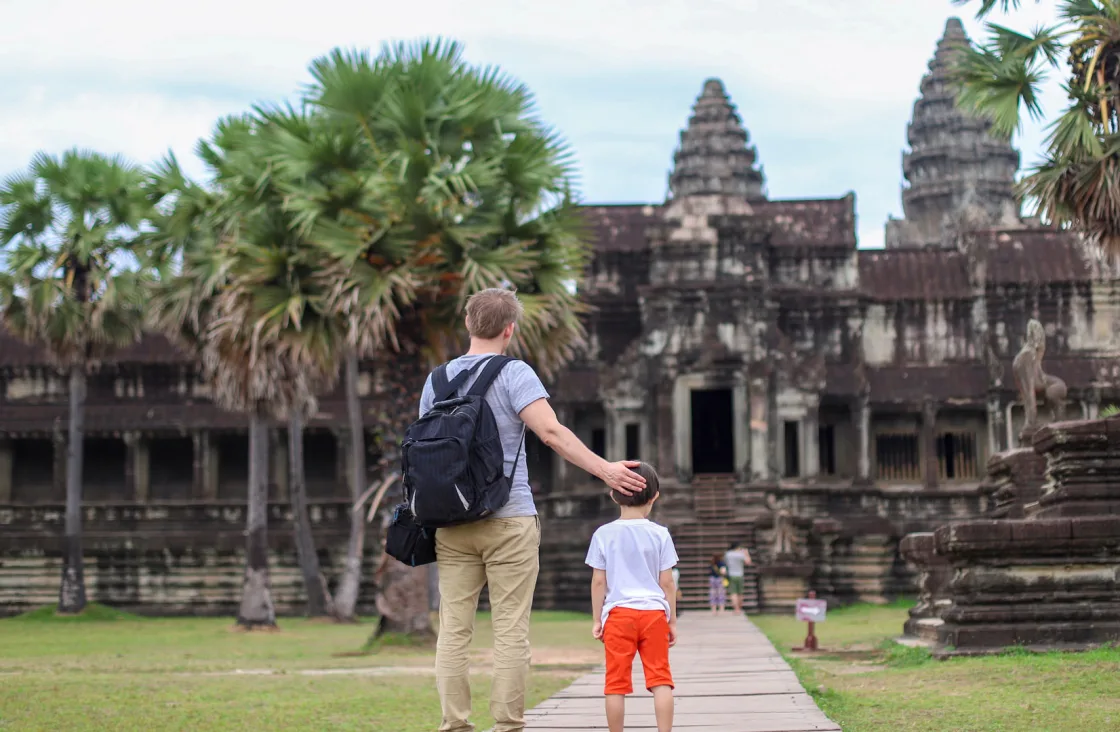
The capital is Phnom Penh, the major language is Khmer, most citizens practice Buddhism, and the currency is Riel. Cambodia is best known for its ancient religious monuments, pleasing scenery, and dark history.
